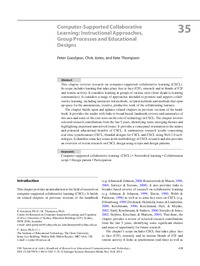Computer-Supported Collaborative LearningInstructional Approaches, Group Processes and Educational Designs
Peter Goodyear, Chris Jones, Kate Thompson
Zu finden in: Handbook of Research on Educational Communications and Technology (Seite 439 bis 451), 2014
|
 |
 Diese Seite wurde seit mehr als 7 Monaten inhaltlich nicht mehr aktualisiert.
Unter Umständen ist sie nicht mehr aktuell.
Diese Seite wurde seit mehr als 7 Monaten inhaltlich nicht mehr aktualisiert.
Unter Umständen ist sie nicht mehr aktuell.
 Zusammenfassungen
Zusammenfassungen
 This chapter reviews research on computer-supported collaborative learning (CSCL). Its scope includes learning that takes place face to face (F2F), remotely and in blends of F2F and remote activity. It considers learning in groups of various sizes (from dyads to learning communities). It considers a range of approaches intended to promote and support collaborative learning, including instructor-led methods, scripted methods and methods that open up space for the autonomous, creative, productive work of the collaborating learners.
This chapter reviews research on computer-supported collaborative learning (CSCL). Its scope includes learning that takes place face to face (F2F), remotely and in blends of F2F and remote activity. It considers learning in groups of various sizes (from dyads to learning communities). It considers a range of approaches intended to promote and support collaborative learning, including instructor-led methods, scripted methods and methods that open up space for the autonomous, creative, productive work of the collaborating learners.The chapter builds upon and updates related chapters in previous versions of the handbook. It provides the reader with links to broad-based, landmark reviews and summaries of this area and some of the core texts on the role of technology in CSCL. The chapter reviews selected research contributions from the last 5 years, identifying some emerging themes and highlighting important unresolved issues. It provides a conceptual orientation to the nature and potential educational benefits of CSCL. It summarises research results concerning real-time (synchronous) CSCL, blended designs for CSCL and CSCL using Web 2.0 technologies. It identifies some key issues in the methodology of CSCL research and also provides an overview of recent research on CSCL design using scripts and design patterns.
 Dieses Kapitel erwähnt ...
Dieses Kapitel erwähnt ...
 Begriffe KB IB clear | CSCLComputer-Supported Collaborative Learning
,  Lernen Lernen learning
, social network analysissocial network analysis learning
, social network analysissocial network analysis
|
 Zitationsgraph
Zitationsgraph
 Zitationsgraph (Beta-Test mit vis.js)
Zitationsgraph (Beta-Test mit vis.js)
 2 Erwähnungen
2 Erwähnungen 
- Technological Pedagogical Content Knowledge - Exploring, Developing, and Assessing TPCK (Charoula Angeli, Nicos Valanides) (2015)


- Cognitive Processes Underlying TPCK: Mental Models, Cognitive Transformation, and Meta-conceptual Awareness (Karsten Krauskopf, Carmen Zahn, Friedrich W. Hesse)


- Cognitive Processes Underlying TPCK: Mental Models, Cognitive Transformation, and Meta-conceptual Awareness (Karsten Krauskopf, Carmen Zahn, Friedrich W. Hesse)
- Digitale Medien in der Schule (Jutta Standop) (2022)

 Anderswo finden
Anderswo finden
 Volltext dieses Dokuments
Volltext dieses Dokuments
 |  Computer-Supported Collaborative Learning: Instructional Approaches, Group Processes and Educational Designs: Artikel als Volltext bei Springerlink ( Computer-Supported Collaborative Learning: Instructional Approaches, Group Processes and Educational Designs: Artikel als Volltext bei Springerlink ( : :  , 301 kByte; , 301 kByte;  : :  2020-11-28) 2020-11-28) |
 Anderswo suchen
Anderswo suchen 
 Beat und dieses Kapitel
Beat und dieses Kapitel
Beat hat Dieses Kapitel während seiner Zeit am Institut für Medien und Schule (IMS) ins Biblionetz aufgenommen. Beat besitzt kein physisches, aber ein digitales Exemplar. Eine digitale Version ist auf dem Internet verfügbar (s.o.). Aufgrund der wenigen Einträge im Biblionetz scheint er es nicht wirklich gelesen zu haben. Es gibt bisher auch nur wenige Objekte im Biblionetz, die dieses Werk zitieren.










 Biblionetz-History
Biblionetz-History